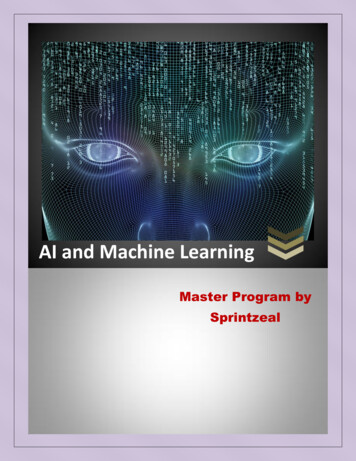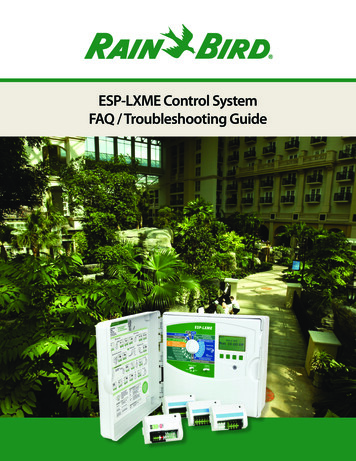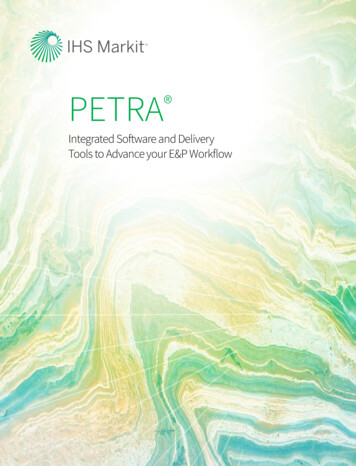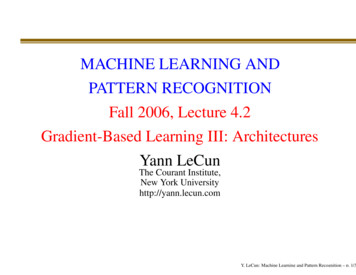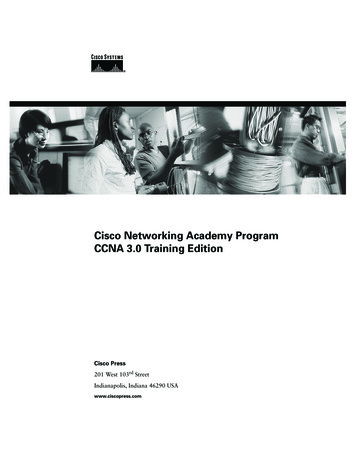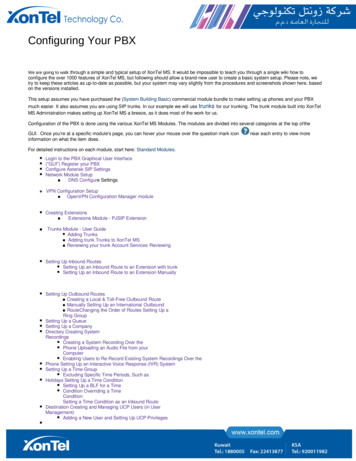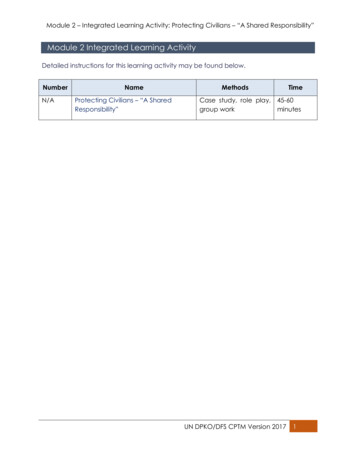
Transcription
Module 2 – Integrated Learning Activity: Protecting Civilians – “A Shared Responsibility”Module 2 Integrated Learning ActivityDetailed instructions for this learning activity may be found below.NumberN/ANameProtecting Civilians – “A SharedResponsibility”MethodsTimeCase study, role play, 45-60group workminutesUN DPKO/DFS CPTM Version 20171
Module 2 – Integrated Learning Activity: Protecting Civilians – “A Shared Responsibility”Module 2 Integrated Learning ActivityProtecting Civilians – “A Shared Responsibility”METHODRESOURCESCase study, role play, group workPURPOSETo consolidate learning on protection issues fromModule 2Learning OutcomesLearners will:Explain “a shared lnerabilities and threats, reporting andresponse planningIdentify actions for POC strategyList specific actions for day-to-day workLearning Activity instructionsLearning Activity steps forparticipantsCase studyResponses to discussionquestionsInformation sheets (same asLearning Activities 2.5.3 and2.5.4)Activity materials (same asLearning Activities 2.5.3 and2.5.4)MapKey messages with slidesTIME45-60 minutesIntroduction: 3 minutes1st Film: 2:06 minutes2nd Film: 1:39 minutes3rd Film: 1:23 minutesGroup work: 15 minutesDiscussion/Presentations: 10-20 minutesKey messages/Close: 10-15 minutesINSTRUCTIONSConsider the case studyIdentify threats and vulnerabilitiesIdentify potential perpetrators and motivesIdentify actions for the mission1st Film:https://www.youtube.com/watch?v Qn5d8H wK82nd Film:https://www.youtube.com/watch?v 6kmo0B1n- 03rd Film:https://www.youtube.com/watch?v u46nQk3SqjIUN DPKO/DFS CPTM Version 20172
Module 2 – Integrated Learning Activity: Protecting Civilians – “A Shared Responsibility”Note on use: This learning activity builds on the learning activities in Module 2 assessingthe vulnerabilities of and threats to civilians – such as Learning Activity 2.5.3 onVulnerability and Threats, Learning Activity 2.5.4 on Four Phases of Response, andLearning Activity 2.6.3 on Responding to CRSV.Films are excellent visual supports. They help prepare peacekeeping personnel,showing them what to expect. Other related short films are also available on YouTube.Consider showing films at the beginning this learning activity to introduce the content inthe case study.Learning OutcomesLearners will:Explain what “a shared responsibility” means in implementing mandated tasksIdentify relevant information for assessing vulnerabilities and threats, as well as forreporting and response planningIdentify actions that should be part of a mission’s POC strategyList and describe specific actions individual peacekeeping personnel can take inday-to-day work that supports mandated tasksPreparationNote the specified learning outcomes for this learning activity.Review relevant content covered in modules 1 and 2. This includes content onhuman rights and protection issues from lessons in Module 2; results from relatedlearning activities in Module 2; content on DPKO Operational Concept in Lesson2.5 on the Protection of Civilians (POC); and content in modules 1 and 2 on thedifferent mission components.Read the case study and Steps for Participants. The case study is drawn fromSouth Sudan. Research the real facts in detail, including actions by the UnitedNations Mission in the Republic of South Sudan (UNMISS). Note that changes inthe country and mission have taken place since 2011-2012, including politicaland geographical changes in the country, crises, and subsequent missionmandates. If participants know their mission of deployment, you may wish todevelop a case study for this activity based on their known mission ofdeployment to deepen knowledge of the mandate and country.Research the mandate for the case study. For the pre-selected case study, this isthe original mandate: Security Council resolution 1996 (2011).Download mission mandates /You must know the start year, country and resolution reference details for themission you wish to search for. For this information, identify the name of ww.un.org/en/peacekeeping/operations/past.shtmlYou may wish to familiarize yourself with key human rights issues in the hostcountry of the case study. If the mission of deployment is known, you may wish todevelop a case study using excerpts from relevant human rights reports. You canuse human rights report from the UN Secretary-General and the UN HighCommissioner for Human Rights. The Office of the High Commissioner for HumanUN DPKO/DFS CPTM Version 20173
Module 2 – Integrated Learning Activity: Protecting Civilians – “A Shared es/PeaceMissionsIndex.aspx.This page also has a link to details on the work of individual human rightscomponents of UN peace missionsRead the Responses to the discussion question for the pre-selected case study,and the key messages for this learning activity. The key messages summarisescontent in Module 2 on specific actions individual peacekeeping personnel cantake to support implementation of mandated tasks.Prepare key points on the responsibility of the UN peacekeeping mission, and “ashared responsibility” amongst peacekeeping personnel. Include points on“vulnerability”, “duty to protect” and “trust”.Prepare notes for the response plan, drawing on the capacity of the mission andpartners. Use relevant content from Module 2.Decide on the groups. The timing for the activity is short. Consider seating peoplein their working groups from the beginning of the day, which will also save time.Make enough copies of the case study and Steps for Participants for allparticipants. Prepare handout packages with the copies. Put these in a folder ontables beforehand to save time. You may wish to distribute the packages theday before to also save time.Prepare flip-chart sheets or a board to record points from discussion.Make sure each group has a flip-chart stand or sheet with flip-chart pens, and anarea of wall which is blank to post the results.Source the films from YouTube:1st Film: UN investigates South Sudan tribal clashes (2:06 minutes)https://www.youtube.com/watch?v Qn5d8-H wK82nd Film: South Sudan forces heading to flashpoint town (1:39 minutes)https://www.youtube.com/watch?v 6kmo0B1n- 03rd Film: Situation tense in South Sudan (1:23 minutes)https://www.youtube.com/watch?v u46nQk3SqjIAccess the films and watch.Check connectivity and the technology needed to show the film. Make sure youhave what you need before the session. Check seating, sightlines and sound.Review the slides and materials on the key messages. Prepare to integrate theKey Messages as part of the learning activity.Instructions1. Introduce the activity, the groups and timing. Be ready to quickly form thegroups if they are not already in place, and refer participants to the handoutpackages on the tables. You may have already identified the groups anddistributed the folders to be read the day before the exercise.2. Introduce and show the films.3. Ask participants to read the case study in their groups. The case study is a trueexample, and brings life to the real challenges faced by ordinary individuals.Participants will play the role of mission personnel working to protect thesecivilians. They must work through the discussion questions to develop a responseplan. The discussion questions are contained in the Steps for Participants.UN DPKO/DFS CPTM Version 20174
Module 2 – Integrated Learning Activity: Protecting Civilians – “A Shared Responsibility”4. Ask participants to answer the discussion questions in their groups. They mustprepare presentations to report-back. Ask each group to choose one person totake notes and report. Ask groups to post responses on the walls or a stand, fora smooth series of short presentations. Encourage participants to draw on otherlearning and experience. Get participants to recall their results from similarlearning activities in Module 2.5. Manage the time. Let groups know when they only have 2 minutes left, so theycan finalize their presentations. During the role play, monitor, circulate andsupport the groups where needed. Only intervene where the discussions go offtrack. .6. Invite teams to brief the full group on their response plan. To save tome, ask eachgroup to present responses to one of the discussion questions. Use the flip-chartto record responses. After each group presents, ask if other groups have pointsto add which have not been covered.7. When all groups have presented, summarize, add points to fill gaps, respond toquestions. Add any actions not mentioned but covered in the materials belowon Responses to the discussion questions.8. Integrate the slides on the key messages at the end. When you present these keymessages, refer to the responses shared in the exercise where relevant. Sharekey points on “a shared responsibility”, “vulnerability”, “duty to protect” and“trust”.9. Close the exercise reinforcing the key messages. Highlight the following:a) It is your work as UN peacekeeping personnel to implement the mandate,and contribute to the success of the missionb) You must know how to contribute to all mandated tasks – whether this is yourprimary/core function, or you play a support rolec) All parts of a peacekeeping mission are essential – respecting each other’swork makes it possible to work together as one, instead of side-by-side butseparately.d) Individual peacekeeping personnel support implementation of mandatedtasks in day-to-day work.e) The mandate to protect civilians is a particularly important one.VariationsHand out the Case Study and discussion questions as homework the eveningbefore the lesson, and ask participants to come prepared to develop a responseplan. This option focuses class time on what a “shared responsibility” means. Askparticipants to deliver brief presentations on their homework. Use the class timefor brainstorming what a “shared responsibility” means and why it is so crucial foreffective peacekeeping. In particular, ask participants to focus on the specificactions individual peacekeeping personnel can take in day-to-day work thatsupports mandated tasks. Note the key messages cover five main actionspeacekeeping personnel can take in daily work. You can give table groups fiveminutes to brainstorm specific details on these five actions. Combine responses.Use the responses to bridge into the key messages.As homework, and ask participants to come prepared with backgroundinformation on the Case Study. Use the background information on the countryUN DPKO/DFS CPTM Version 20175
Module 2 – Integrated Learning Activity: Protecting Civilians – “A Shared Responsibility”and missions to complete detailed assessments of vulnerabilities and threats, andcreate informed response plans. Encourage research using different media,including reports, maps, photos, and films. This is particularly useful whereparticipants know the mission of deployment, and a case study has beendeveloped for this activity based on this. Assign groups to carry out research onall or specific topics such as:a) Country profileb) The UN peacekeeping missionsc) Relevant mission mandated) key human rights issuese) Perpetrators of human rights abuses and violationsf) Causes of the conflict in the country and the specific geographic locationg) Relevant peace agreementsh) Geographic location, terrain and weather conditionsi) Host state capacityj) Country infrastructurek) Background information on relevant communitiesl) Vulnerable groupsm) Protection/ humanitarian actorsn) Local protection strategiesInclude the relevant mission mandate as part of the materials for the participantsto use. This further allows participants to read and understand Security Councilmandates. Time is limited. Consider giving copies of mandates the day beforethe session, as homework. If not possible, give extra time at the beginning of thesession for participants to read the mandates and plan to use fewer questions.Prepare key points based on the mandate as part of the debrief. Guideparticipants to consider details in the mandate on cross-cutting thematic taskswhich link to international law. Examples include:a) Tortureb) Gender-based and sexual violencec) Violence against childrend) The recruitment and use of child soldierse) The trafficking of human beingsf) The intentional denial of humanitarian assistanceHand out both the mission mandate and excerpts from relevant human rightsreports as part of the homework before the exercise.UN DPKO/DFS CPTM Version 20176
Module 2 – Integrated Learning Activity: Protecting Civilians – “A Shared Responsibility”Module 2 Integrated Learning Activity Steps for Participants: Protecting CiviliansConsider the case study.You are deployed to the mission in South Sudan. As part of UNMISS, you share theresponsibility to protect civilians with all other peacekeeping personnel.If you are to achieve the goal of protecting civilians you must all work as a team toeliminate the threats or mitigate the risks.The mission needs a response plan. You are asked for advice.STEP 1: Threats to civiliansIdentify the threats to civilians.Identify the threats which are specific to women, men, girls and boys.STEP 2: Vulnerability assessmentIdentify vulnerabilities of the civilian population.Which civilians are most vulnerable?Fill in the sheet.STEP 3: Threat assessmentAssess the threat in more detail.Identify the potential perpetrators and their motives.Fill in the sheet.STEP 4: Action planIdentify actions for the mission at each phase.Identify roles of military, police and civilians (including for substantive andsupport components).Fill in the sheet.What specific actions should the mission take to protect women and children?How should the mission engage with the local community?What information should the mission continue to gather?Identify areas for coordination within the mission and with mission partners.Nominate one person in your team to present your proposed response plan.UN DPKO/DFS CPTM Version 20177
Module 2 – Integrated Learning Activity: Protecting Civilians – “A Shared Responsibility”Module 2 Integrated Learning Activity Case study: Protecting CiviliansSouth SudanBackgroundDecades of civil war within Sudan between the north and south finally ended in 2005.The first civil war started in 1955 over the independence of southern Sudan, and thesecond civil war starting in 1983 between the Government of Sudan and the SudanPeople’s Liberation Movement (SPLM) was a continuation of the conflict.The Comprehensive Peace Agreement (CPA) signed on 9 January 2005 between theGovernment of Sudan and SPLM ended Africa’s longest running civil war. The CPA alsocalled for a referendum to take place to determine the status of southern Sudan.In January 2011, the referendum was held. The result was an overwhelming majority,98.83% of participants, voting for independence. On 9 July 2011, the Republic of SouthSudan became the newest country in the world.However, independence did not bring an end to problems in southern Sudan. At theend of more than 20 years of civil war, at least 1.5 million people had been killed, and 4million people were displaced. The newly born state of South Sudan continued to facehumanitarian crises.Also, independence did not bring an end to conflict in southern Sudan. Conflictcontinued between Sudan and South Sudan over oil and border demarcation including of conflict over Southern Kordofan and Blue Nile States, as well as who waseligible to vote in the referendum to determine whether Abyei will remain part of theSudan or join South Sudan.Conflicts between rival tribes within South Sudan over cattle, land and grazing rightsalso escalated. During the civil war the tribes of southern Sudan were united in thecommon battle for independence. Now ethnically based militias kill and conduct cattleraids in the Warrap, Unity and Jonglei States.In July 2011, the United Nations Mission in the Republic of South Sudan (UNMISS) wasestablished to consolidate peace and security, and help support the development ofSouth Sudan. The mandate of the United Nations Mission in Sudan (UNMIS) – which wasestablished in March 2005 to support the implementation of the CPA – ended on thesame date.UN DPKO/DFS CPTM Version 20178
Module 2 – Integrated Learning Activity: Protecting Civilians – “A Shared Responsibility”Ethnic Conflict between Lou Nuer and Murle Tribes in Jonglei State, 2011-2012The troubled state of Jonglei has a long history of ethnic tensions, cattle raiding,kidnappings and sometimes violent competition for scarce resources. Conflicts such asthese “cattle vendettas,” as well as other clashes between rival groups, are common inSouth Sudan but have serious consequences on the civilian population and posegreater security risks to the displaced people.For example, fighting between the rival Lou Nuer and Murle tribes is common. The Murleand Lou Nuer are both agro-pastoralist tribes that depend largely on subsistencefarming and cattle-herding. Historically, ethnic clashes and cattle raids are a result ofthe demand for high bridal dowries.In the past, such clashes were conducted with spears. Easy access to weapons led to achange. Following independence, ethnically based militias are now armed withmachine guns and vehicles. The ethnic massacres in Jonglei State have taken on agenocidal character. Women and children are targeted for killings and abduction as atactic in these conflicts.During the start-up phase of the UNMISS, reportedly, the Murle tribes raided the cattlefrom the Lou Nuer in August 2011. They also caused injury to men and women, andkidnapped children from the neighbouring areas.This triggered retaliatory action from the Lou Nuer tribe. After having organized the selfproclaimed Nuer White Army made up of Lou Nuer youths began to threaten revengeattacks against the Murle. They warned UNMISS to leave the area, and eventhreatened to fight both UNMISS and the South Sudanese army if necessary, as theyfought the Murle tribe.Efforts of negotiations to stop the fighting failed. In December 2011, without paying anyheed to the international call to stop fighting, the Lou Nuer launched swift attacks on toMurle in different areas, killing approximately 600 people instantly. The attacks were ledby the Nuer White Army, a group of as many as 6, 000 to 8,000 armed youth from theLou Nuer ethnic group. The intention was to reclaim stolen cattle and the 180kidnapped children that the Murle had allegedly taken from their communities.The armed youth were largely from ethnic Lou Nuer villages in central Jonglei State,and attacked ethnic Murle villages in the eastern part of the state, including Murlecivilians living in the remote areas of Pibor county. The attackers burned and lootedhomes; killed and injured people using machetes, sticks, knives, and guns; abductedwomen and children; seized hundreds of thousands of cattle; and forced tens ofthousands of people to flee their homes to hide in the bush. A witness who was at thescene several days after the attack stated that he saw the dead bodies of civilians,including women who appeared to have been raped with blunt objects.Retaliation attacks were then carried out by Murle in January and February 2012. Duringthe period of 2011-2012 attacks and counter-attacks by Murle and Lou Nuer tribesUN DPKO/DFS CPTM Version 20179
Module 2 – Integrated Learning Activity: Protecting Civilians – “A Shared Responsibility”continued. Deaths included Murle, as well as Bor Dinka and Lou Nuer in revengeattacks by Murle during the same period.The United Nations claim that about 350,000 people were displaced as a result of thiskind of violence in 2011. At the beginning of 2012, South Sudan declared Jonglei Statea disaster zone after as many as 100,000 people were forced to flee from fightingbetween the rival Lou Nuer and Murle tribes.Many people from both Murle and Nuer communities were treated for machete andgunshot wounds at clinics in Pibor, Juba, and Malakal. International aid groupsstruggled to provide assistance to more than 140,000 people affected by the fighting.The absence of South Sudanese police made communities especially vulnerable duringthese conflicts.The government of South Sudan had no heavily equipped army to stop the raids.During the 2011-2012 attacks and counter-attacks, the South Sudanese army was toolate to deploy adequate forces to protect communities, even though they werewarned. Soldiers of the South Sudanese army also have a reputation of committingserious human rights violations against civilians.Government officials may have been involved in organizing the violence, or at leastinciting the violence.(Sources: Human Rights Watch, “South Sudan: Justice Needed to Stem Violence,”Prosecute Those Responsible, Seek International Investigation, February 2012; HumanRights Watch, “South Sudan: Army Making Ethnic Conflict Worse,” Abusive Tactics, Lackof Protection, Send Civilians Fleeing, July 2013; Genocide Watch, “South Sudan,”website accessed March n.htmlUN DPKO/DFS CPTM Version 201710
Module 2 – Integrated Learning Activity: Protecting Civilians – “A Shared Responsibility”Module 2 Integrated Learning Activity Responses: Protecting CiviliansThreats to CiviliansThreats to life – killing during Lou Nuer attack to MurleThreats to property – Theft of cattle during Murle attack on Lou NuerThreats to physical integrity – Injury to men and women; kidnapping of children(Murle attack on Lou Nuer); rape of womenThreats to freedom – Displacement of populationAction PlanPhase 1: Prevention:Police/military patrols in volatile areas.Carry out human rights monitoring in volatile areas (deployment of Human RightsOfficers).Engage community leader (paramount chiefs) in reconciliation and mediationefforts (deployment of Civilian Affairs Officers).Constant liaison and advocacy with government and other non-governmentarmed actors.Set up of early warning systems.Disarmament of the affected Murle, Nuer, and Dinka communities.Security sector reform for the national police and army.Phase 2: Pre-emption:Increase deployment of military/police and patrols to volatile areas.Increase human rights monitoring, reporting and advocacyStep up mediation efforts at the local and national levels.Launch public information campaign to sensitise the population of differentgroups.Phase 3: Response:Deploy police/military personnel to create a “buffer zone” between vulnerablepopulation and potential aggressors.Use of force in case vulnerable population is under imminent threat of physicalviolence.Step up mediation efforts to include regional and international actors – politicaland economic pressure on potential aggressors.Phase 4: Consolidation:Liaison with the parties to the conflictDialogue with civilians affected by conflictInvestigation into human rights violationsLiaise with the South Sudan Human Rights Commission for a thoroughinvestigation identifying the perpetrators and politicians inciting violence, inorder to bring them to justice.Launch of confidence building measures to re-establish trust between affectedpopulation and governance institutions that have been brokenDisarmament of the affected Murle, Nuer, and Dinka communities.Security sector reform for the national police and army.UN DPKO/DFS CPTM Version 201711
Module 2 – Integrated Learning Activity: Protecting Civilians – “A Shared Responsibility”Gender-sensitive and child protection considerations for response planningNumber of males/females according to age-groupsThreats to women/girls, men/boysConsult on community scans to help understand the area (protection/securityneeds – especially for women and children)Take note of unaccompanied or separated childrenNote vulnerable groups: including children, women, ethnic or religious minorities,refugees, internally displaced people, people with disabilities, wounded and theelderly.Engagement with local communityInnovative examples from UN peacekeeping:Joint Protection Teams (JPTs): A small mixed team drawn from the mission’smilitary, police, human rights and other civilian units. The aim is to enhance thepreventive and responsive action for civilians at risk. This includes improving earlywarning mechanisms and analysis of existing or potential threats to civilians,supporting the development of local protection plans in areas where UN militarypersonnel are deployed, as well as establishing or reinforcing existing localcoordination structures with local authorities, communities or humanitarianpartners. The JPTs visit areas identified as “at risk”, carry out assessments, andthen write up reports.Community Liaison Assistants (CLAs): Deployed to support the protectionactivities of the mission’s military component, at the company or platoon level.They are national UN staff members (in other words, nationals of the host countrywhere the mission is deployed), although not drawn from a particular area inwhich they work. They are tasked with outreach activities to facilitatecommunication with the local authorities, communities, and humanitarianpartners. CLAs also respond to the longer-term objective of building nationalcapacity on POC, by encouraging communities to develop their own protectionmechanisms.Community Alert Networks (CANs): Established by the mission around its militarybases. By distributing mobile telephones to focal points in the villages surroundingthe UN base, CANs aim to cover high priority areas benefitting from mobilenetwork coverage. Selected in consultation with the local community, focalpoints are generally drawn from local leadership and then alert the CLAs or UNmilitary commanders when there is a threat to the security of the local civilianpopulation. A CAN Committee is in charge of adapting the model as required,reviewing and suggesting other technology based options, or liaising withpartners on any potential extension of the telephone network in priority areas.Some UN military bases, not covered by telephone networks, have distributedhigh frequency radios to facilitate communication.UN DPKO/DFS CPTM Version 201712
Module 2 – Integrated Learning Activity: Protecting Civilians – “A Shared Responsibility”Essential information for investigation and follow-upNote: You must protect sensitive information.Information on human rights violations and abuses:Date, time, location of incidentDetails of victims(s) (name, age, sex, address)Note information on child(ren)(with parents, or unaccompanied/separated)Details of witness(es) (name, age, sex, address)Details of perpetrator(s) (name, age, sex, address – physical features foridentification)Details on what happened (how, when, where)Note human rights violations/abusesInformation on armed groups/forces:Where armed forces and groups are (location)Demographics of their members, grouped by sex and ageTheir weapons stocksInformation gathered through community scans:Gather perspectives on the status of the community, needs, threats, impact ofthe conflict and highest priorities of each groupEnsure no group is left out, especially the marginalized as part of communityscans to help understand the areaInformation on situational awareness:Up-to-date information on current situations on the ground change is key.Political and conflict dynamics, nationally and locally (politics, conflict drivers,local context)Emerging security threatsIdentify security gapsRegular threat assessments:Consider larger political and security dynamicsAnalyse intent and capacity for violence of possible perpetratorsAssess the opportunity for a threat to happen – time, location, terrain andweather all influence opportunity for a perpetrator to inflict violenceRegular risk assessments:Likelihood of threat occurringVulnerability of a civilian population – an assessment of vulnerabilities helps toidentify civilians and communities who are most at riskPresence, capacity and intent of protection actorsUN DPKO/DFS CPTM Version 201713
Module 2 – Integrated Learning Activity: Protecting Civilians – “A Shared Responsibility”Module 2 Integrated Learning Activity Information sheet: Protecting CiviliansThreatsTo life Arbitrary, summary or extrajudicial executionsMurder (from individual killings, to systematic violence andgenocide)To physicalintegrity Torture, cruel, inhuman or degrading treatmentRape and other forms of sexual violence (from opportunistic towidespread and systematic use)AbductionDeliberate deprivation (of food, water, other goods or servicesnecessary for survival)To freedom Forced disappearanceArbitrary/illegal arrest and detentionRestrictions on freedom of movement (including forceddisplacement)Forced labor or recruitmentTo property Theft, extortion (e.g. illegal taxation)LootingUN DPKO/DFS CPTM Version 201714
Module 2 – Integrated Learning Activity: Protecting Civilians – “A Shared Responsibility”Module 2 Integrated Learning Activity Information sheet: Protecting ngagements;securitysectorreformprogrammes; targeted advocacy; joint operations orjoint ion;mission-widecommunity engagement cooperation mechanismssuch as Joint Protection Teams, Community LiaisonAssistants, Community Alert Networks, localizedprotection strategiesHumanitarianCommunityProtection Cluster led by UNHCRParallel ForcesInformation sharing and operational planning on acase-by-case basis, including HOM exchanges andworking-level cooperationUN DPKO/DFS CPTM Version 201715
Module 2 – Integrated Learning Activity: Protecting Civilians – “A Shared Responsibility”Module 2 Integrated Learning Ac
1st Film: 2:06 minutes 2nd Film: 1:39 minutes 3rd Film: 1:23 minutes Group work: 15 minutes Discussion/Presentations: 10-20 minutes Key messages/Close: 10-15 minutes INSTRUCTIONS Consider the case study Identify threats and vulnerabilities Identify potential perpetrators and motives Identify actions for the mission 1st Film:
